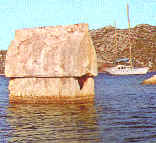|
|
These verdant shores, where densely pine forested mountains give way to tea terraces, hazel nut groves and tobacco plantations, confound those who envisage Turkey as sun-baked steppe land.
The rugged Pontic Mountains plunge steeply down towards the sea, making this coastline one of craggy cliffs and headlands interspersed with sandy beaches. Owing to the mountainous character of the region, much of the settlement is scattered over hill slopes, and the only agglomerated settlements are towns and fishing villages on the narrow coastal belt.
Cut off from the rest of Turkey by Pontic Chain, Black Sea coast has pursued somewhat independent history. According to the legend, these shores were the land of Amazons, and an Amazon queen is said to have founded Sinop.
In 1st century BC, Kingdom of Pontus, comprising the whole of this coast, was ruled by Mithradates VI Eupator, who successfully defied Rome for 22 years, until he was forced into flight and suicide by Roman General Pompey.
In the later Middle Ages, the coast once again became the center of an independent empire, Comnene Empire of Trebizond (now Trabzon). In fact Trebizond was the last Byzantine city to hold out against Ottoman Turks, and it was only 8 years after the fall of Constantinople that the last Comnene Emperor surrendered to Sultan Mehmet II, the Conqueror.
Along the Western part of Black Sea cost are several small resorts with sandy beaches, such as Kilyos (on European side of Black Sea coast), Sile and Akcakoca (on Asian side). The succession of resorts is interrupted by Eregli and Zonguldak, Turkey's largest coal and steel centers. Beyond Zonguldak is the picturesque town of Amasra, clustered around Byzantine citadel on promontory between two beaches.
Following the Eastern Black Sea coast, from Sinop to Hopa, greatly facilitates sightseeing. Sinop is famous as the birthplace of great Cynic philosopher Diogenes, and there are several interesting Seljuk buildings.
From Sinop to Samsun, the road passes through maize and tobacco plantations, for which the region is famous. Though the settlement of Samsun is ancient, little remains to testify to its past. Nevertheless, the town has important place in modern Turkish history, since it was here that Ataturk landed to organize the national resistance that liberated Turkish territory from foreign powers.
Covering the hill slopes from Samsun to Trabzon are hazel nut groves, which made Turkey the world's largest exporter of this crop.
Unye, the ancient Oinoe, is attractive resort surrounded by sandy beaches. Much resembling Unye is the port of Ordu, from where Xenophon and his 10,000 mercenaries embarked for Heraklia ad Pontus in 401 BC.
Giresun is beautifully set around high rocky peninsula, crowned by Byzantine fortress. The town is surrounded by lush cherry orchards and it was from here that Roman general and gourmet, Lucullus, brought back the first cherry trees to Europe.
Trabzon, Byzantine Trebizond, was well fortified city, on sloping table of ground beyween two ravines, and it was one of the few Byzantine cities to resist attacks by Seljuk Turks and Mongols.
Remains of Trabzon's Byzantine fortress can still be seen, and also in the city there are many buildings reflecting the two hundred years Commune rule, such as Church of St. Sophia with its interesting frescoes and relieves.
Outside Trabzon in Zigana Mountains is Monastery of Sumela, set like swallow's nest in sheer rock face. Most of the monastery was built in 14th century during the reign of Alexius III Comnene, and contains many fine frescoes.
After Trabzon, the land of tea terraces begins, while covering the uncultivated slopes are purple wild rhododendrons, another plant that originated in this fertile region . Rize is the center of this tea producing region, which supplies Turkey with tea.

Kekova
|
|

